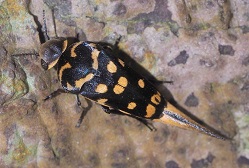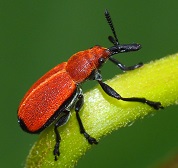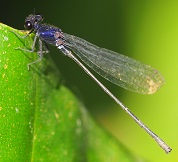| Home | Nature Weekly Index |
28 May 2017 | Walk at the Park |
 After spending a few weekends at the park next to my home to test out my macro lens, I decided to venture further to
Admiralty Park to find more gems. The trip proved to be very fruitful. Many of the little creatures which I had difficulty
getting a decent pictures in the past due to their mini size had become relatively easier now. Also, I could keep a bit
more distance from my target objects which prevented them from dashing off for safety if I were to get too close. Of the
many creatures that I had encountered, a few interesting ones were highlighted below.
After spending a few weekends at the park next to my home to test out my macro lens, I decided to venture further to
Admiralty Park to find more gems. The trip proved to be very fruitful. Many of the little creatures which I had difficulty
getting a decent pictures in the past due to their mini size had become relatively easier now. Also, I could keep a bit
more distance from my target objects which prevented them from dashing off for safety if I were to get too close. Of the
many creatures that I had encountered, a few interesting ones were highlighted below.
First on the list was a hover wasp. At least 3 of these wasps were hovering in the same area, settling down for very brief moment before taking off again. After waiting patiently, I only mange to get a single picture. Fortunately, it turned out well. It reminded me of a Wasp-mimic Hoverfly which I saw two years back in this same park. Back then, I was wondering which wasp this hoverfly was trying to imitate. The mystery was unveiled at this trip. However, the identity of the wasp remained a mystery for now. The main differentiator between a hoverfly and a wasp is their antennae.

 The next two were beetles, a Tumbling Flower Beetle and a red
Weevil. The Tumbling Flower Beetle that I often encountered was
Glipa malaccana which seemed to be affiliated with
a fern, Blechnum finlaysonianum. The newly spotted Tumbling
Flower Beetle had some orange spots on its body. A few of them were moving around on the remains of a tree trunk that laid
horizontally on the ground at the periphery of a track. Besides this unknown species, there was another species seen which
was black in colour and very tiny in size. Despite my improved equipment, I was still unable to take a good picture of it.
As for the red Weevil, its colour was the most distinctive feature. Colour of most Weevils were often dull, either black or
brown in colour. Since I found 2 of them on the
Rangoon Creeper (Quisqualis indica), I had good reason to suspect
that this climber might be its host plant. Similarly, no idea on their identity yet.
The next two were beetles, a Tumbling Flower Beetle and a red
Weevil. The Tumbling Flower Beetle that I often encountered was
Glipa malaccana which seemed to be affiliated with
a fern, Blechnum finlaysonianum. The newly spotted Tumbling
Flower Beetle had some orange spots on its body. A few of them were moving around on the remains of a tree trunk that laid
horizontally on the ground at the periphery of a track. Besides this unknown species, there was another species seen which
was black in colour and very tiny in size. Despite my improved equipment, I was still unable to take a good picture of it.
As for the red Weevil, its colour was the most distinctive feature. Colour of most Weevils were often dull, either black or
brown in colour. Since I found 2 of them on the
Rangoon Creeper (Quisqualis indica), I had good reason to suspect
that this climber might be its host plant. Similarly, no idea on their identity yet.
 The last candidate was a male damselfly known as Shorttail (Onychargia atrocyana) which was supposed to
be uncommon according to the
"Photographic Guide to the Dragonflies of Singapore"
(page 75). Its unique feature was the dark blue thorax. Besides butterflies and dragonflies, damselfly was probably the
next easier group of insects to be identified since their identity was quite well documented with good pictorial guides
available.
The last candidate was a male damselfly known as Shorttail (Onychargia atrocyana) which was supposed to
be uncommon according to the
"Photographic Guide to the Dragonflies of Singapore"
(page 75). Its unique feature was the dark blue thorax. Besides butterflies and dragonflies, damselfly was probably the
next easier group of insects to be identified since their identity was quite well documented with good pictorial guides
available.
One of my aim on this trip was to obtain better quality pictures on the flea beetles which I often found in a particular location of this park. I had identified it as a Longitarsus species. Due to its tiny size, good pictures were hard to come by. Since I knew where the beetles are and I was better equip, the mission was accomplished.
At about 4 pm, I had to head home after spending 4 hours in the park since my camera battery was flat. I had learned that a full battery could last for over 500 photos; 536 to be exact.
Update: 9 July 2017
The identity of the unknown hover wasp should be a Metischnogaster sp. A picture of Metischnogaster species appeared in a 2015 article (page 44) and it looked very similar this wasp that I saw in the park.